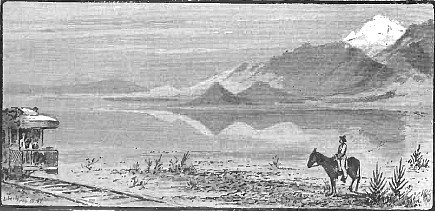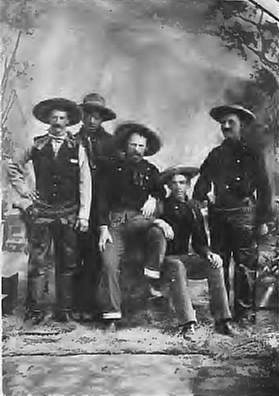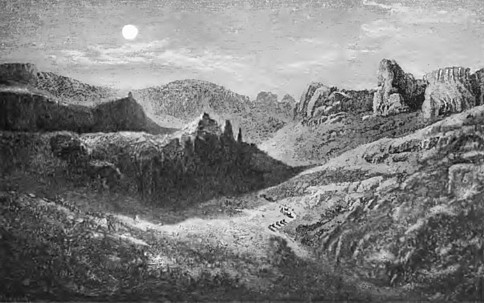AGUA FRIA YAVAPAI
COUNTY
This district, located in the southern portion of the county, east of
the Black Canon District, contains gold, silver and copper mines, but they
have not as yet been developed to any great extent. It is said that rich
discoveries have recently been made in this section.
AJO MINES, PIMA COUNTY.
These copper mines, which were discovered by Mexicans a long time ago, are
situated in the western part of the county, forty miles south of the Gila
River, and one hundred miles from Yuma. Shortly after our purchase of the
Territory, they were opened and worked by American capital, the
copper ore being hauled to Yuma, through a desert country, and then
shipped to Swansea or Boston. Although the ores were rich and abundant, yet
this method proved so expensive that operations were suspended.
ARIVACA, PIMA COUNTY
This district is in the extreme southern portion of the county,
adjoining Oro Blanco District. The Heintzelman, a well known mine, was
located and worked some years ago, but is now lying idle. It has a working
shaft 230 feet deep, and several prospect shafts from ten to fifty feet
deep. The
zinc ore is a kind of
sphalerite, and frequently of very high grade, giving assays
as high as $4,000 to the ton, but it is exceedingly base, and has to be
worked by the leaching process. This mine has yielded about $850,000. The
Juiche is an old mine, which has a shaft down sixty-five feet, and some open
cuts showing rich ore. The Consolidated Arizona Gold and Silver Mining
Company, Mr. John McCafferty, Superintendent, employs from forty to fifty
men. The working shaft is down 160 feet, and is surmounted by good steam
hoisting machinery. Levels have been opened, and' a number of crosscuts run,
which show ore said to mill $100 per ton. The company has erected a ten
stamp mill, which is now in operation.
The Arkansas, belonging to Farr & Unthank, is being vigorously developed. The shaft is down 300 feet, and the vein, which at first was quite narrow, is widening out. At this depth it averages S400 per ton; where it was first struck, it carried virgin silver, yielding from one dollar to five dollars per pound. This rich ore is being shipped to San Francisco for reduction. At the Lonjarina mine, ore is being extracted and worked in the Derre & Townsend mill. It is argentiferous galena, and averages eighty-five ounces to the ton. The Albatros mine is also being developed, and has a shaft down about seventy-five feet, all the way in good silver ore. There are many other promising locations in this district, among which may be mentioned the Ortega, Tennessee, Vale of Ranja, Hombre, Plomosa, Union, Dos Amigos, Mentor, and Alpha.
AUBREY, MOHAVE COUNTY
This is a large district in the southern part of the county, bounded on
the south by Bill Williams Fork, and on the west by the Colorado River. The
eastern part embraces the Hualapais range of mountains, in which, during the
past ten years, a large number of silver ledges have been discovered. At
present but little is being done in the district, the rich discoveries in
other more accessible sections of the Territory having diverted attention
from this promising region. The noted McCracken Silver mine, located in the
northeastern portion of the district, was discovered in 1874 from croppings
which extended nearly north and south for a distance of ten miles. The vein
at the surface is, in some places, eighty feet wide. The best milling ore of
the McCracken averaged about ninety-five dollars per ton, although there
were narrow streaks which were much richer. This mine has been worked to a
considerable extent, and for a time yielded a large amount of bullion. The
Signal and Palmetto are adjoining mines on the same ledge, which have also
produced a large amount. At the Peabody mine, ore is being extracted and
worked in a twenty-stamp mill at Signal.
AZTEC, PIMA COUNTY
This is an old district, lying east of the Tyndall and north of the
Patagonia District, embracing within its limits the southern part of the
Santa Rita Mountains. The general formation is
granite, syenite, and porphyry. The mineral veins are numerous, and
several of great width show distinct croppings for long distances. Evidences
of mining which must have been done in olden times occur along these veins.
Some of the rich mines worked by the Jesuits are supposed to have been
located in this vicinity. The Aztec Syndicate, a large mining company, made
this the center of their operations. The Sonoita Creek at a short distance
affords plenty of water for milling, and wood is abundant; oak and mesquite
being found on the slopes and lower ranges, while higher up on the mountains
is pine, which makes good lumber. Springs of excellent water are plentiful,
and much of the surface is covered for several months in the year with fine
gramma grass. No other district offers better facilities for mining than
this. The gulches have all afforded placer
gold nuggets, and a considerable district lying east is more
or less worked in this way. Mr. Campbell, who represents an Eastern company,
is now engaged in opening some mines here, with excellent prospects.
BIG BUG, YAVAPAI COUNTY
Big Bug District is a short distance east of Prescott, adjoining the
Turkey Creek District. The Bell, a silver mine, has a shaft 180 feet in
depth. The vein, which is thirty inches in width, carries smelting ore
assaying as high as $160 per ton. The Poland, Hamilton, Bullion, and
Mountain Boy, belonging to the Stokes Mining Co., and the claims of the
Valley Forge Mining Co., are also promising locations.
BILL WILLIAMS FORK,
YUMA COUNTY
This district, located in the extreme northwestern portion of the
county, is bounded on the west by the Colorado River and on the north by
Bill Williams Fork, a tributary of the Colorado. During the
gold rush excitement in regard to placer diggings in this vicinity
several years since, considerable prospecting was done for
gold quartz, resulting in the discovery of the Planet, one of
the largest and best known copper mines in Arizona. It has been worked at
different times to a considerable extent, yielding ore of a very high grade,
from which several thousand tons of copper have been extracted. There are
many other rich veins of copper ore in the district, and when this region
becomes more accessible they will no doubt be worked on an extensive scale.
BLACK CANON, YAVAPAI
COUNTY
This district lies immediately east of Humbug and Pine Grove Districts,
on the eastern slope of the Bradshaw Mountains. The ledges in this section
are almost exclusively gold-bearing; the formation,
slate and granite. The Valanciana mine, the oldest location in the
district, was discovered in 1860 by Hutchinson and Carpenter. It has yielded
about $45,000. The Iconoclast, owned by Wickenberg and Cochran, has a vein
16 feet wide, which averages $25 per ton. As the ore is crushed by an
arrastra, only that which has been closely assorted is worked. This
gives $100 per ton. The Clipper, owned by Curtis and Trotter, is also worked
by an arastra, and yields $100 per ton. The Gillespie has a six foot vein,
which is said to average $40 per ton. Sufficient rock is taken out to keep
two arastras running. The Nigger Brown mine, owned by John Anderson, has ore
which pays about $25 per ton. There are altogether about sixty locations in
the district, many of which have been sufficiently prospected to prove that
they possess good milling ore. No mills have yet been erected, all the ore
being worked by the slow process of arastras. Wood is scarce, and lumber has
to be hauled 25 miles.
BLACK HILLS, YAVAPAI
COUNTY
This district, located in a range of hills east of Prescott, is said to
abound in gold and silver ledges, but they have not as yet been developed to
any great extent. On the western slope large quantities of copper float of a
high grade have been found, indicating the existence of extensive ledges of
copper ore.
BLOODSUCKER, PIMA
COUNTY
This district is situated in the foot-hills of the Bloodsucker
Mountains, 45 miles northwest of Tucson. The mines were discovered and
several locations made by D. B. Rea and others about January, 1880. The
formation is granite, syenite, and slate, containing veins carrying both
gold and silver ore, but gold predominates. Springs of good water are found
throughout this section, and wood, principally mesquite, is abundant.
BRADSHAW, YAVAPAI
COUNTY
See Tiger District.
BRON
See Tombstone District.
COCHISE, COCHISE COUNTY
This district is in the Dragoon Pass, on the northern end of the Dragoon
Mountains, near the line of the Southern Pacific Railroad. The formation is
granite, lime, and porphyry. The ores are mostly carbonates, containing both
gold and silver. Several claims have been bonded to Eastern parties, who are
now developing them. There is a fair supply of timber on the mountains,
principally scrub oak; and water for milling purposes can be obtained by
sinking.
CALIFORNIA, COCHISE
COUNTY
This district is situated in the eastern part of the county, embracing a
portion of the Chiricahua range of mountains. Its general altitude is from
5,000 to 6,000 feet, giving it a cool and healthy climate. The summit of the
main range of mountains is covered with fir and yellow pine, furnishing
lumber and fuel. Water of a good quality is obtained from springs and
brooks, which are quite numerous in this section. Gayleyville, the principal
town, is twenty-five miles from San Simon, a station of the Southern Pacific
Railroad. The rock formation of the mineral belt is metamorphic
limestone, syenite, and porphyry. The silver ores are generally
argentiferous galena, which have to be smelted. The silver is readily
obtained as the ore carries its own flux. The Texas mine is opened by a
shaft 150 feet deep, from which several prospecting tunnels have been run.
It is said to have an eight foot vein of ore, which assays $100 per ton.
There is a large amount of ore on the dump. The company has recently put up
a smelting furnace, which is in active operation. The Continental mine has a
narrow vein of black metal ore of very high grade. It is being extracted,
sacked, and shipped to San Francisco. The Roman Beauty, another very
promising mine, is being energetically developed, and bids fair to soon rank
with some of the producing mines of other sections. The Hell mine has a
shaft down 85 feet and the ledge at that point is 14 feet wide, and carries
an 18 inch pay streak of high-grade ore. In addition to the above are the
Cleveland, Hardshell, Bruce, Humming Bird, East End, Keystone, and other
mines, which are being developed and yielding rich ore.
Return
to The Arizona Page:
Arizona Gold Rush Mining History




